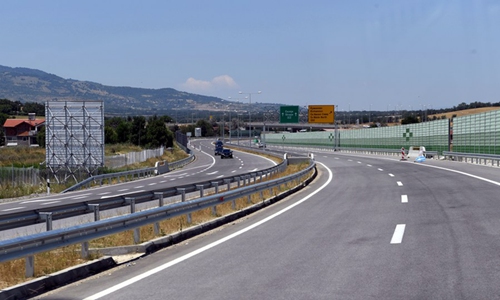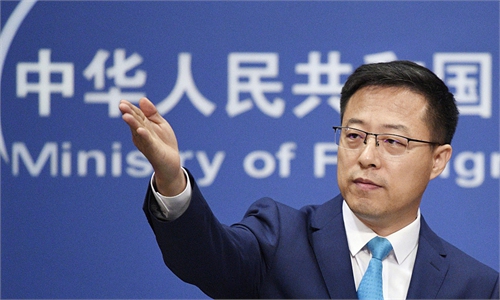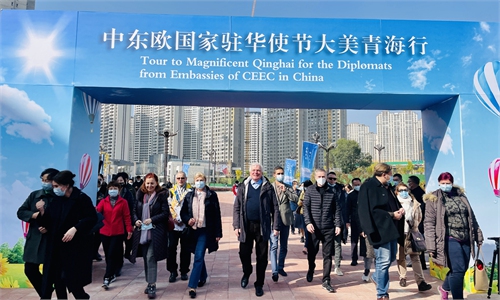BRI a strong, mutually beneficial link between China, CEEC: North Macedonian scholar
'Balkan Silk Road' becoming a new, emerging transport route and economic corridor: scholar

Vehicles move on the Miladinovci-Shtip highway section which connects North Macedonia's capital Skopje with the eastern part of the country, July 6, 2019. The 47-km highway section was constructed by a Chinese company. Photo: Xinhua
Editor's Note:
In 2013, Chinese President Xi Jinping put forward the "Belt and Road Initiative" (BRI), aimed at building a new platform for international cooperation and creating new momentum for shared development. Central and Eastern European countries (CEEC), being part of logistics network that facilitates land connectivity between Asia and Europe, have become a vital component of the mega scheme to date. The BRI also synergized with China-CEEC Cooperation platform, bringing a mutual beneficial cooperation momentum that certain countries' withdrawal was not able to generate an impact.
The Global Times (GT) recently spoke with Simona Spirkoska (Spirkoska), an expert at the Confucius Institute of North Macedonia, sharing her view on how BRI has facilitated China-CEEC trade connectivity and contributed to local social and economic development.
This is the fourth in a series scoping the views of foreign experts on the remarkable contribution made by the BRI and China - the world's second-largest economy - to global development over the past 10 years.
GT: This year marks the 10th anniversary of the launch of China-Central and Eastern Europe Countries (CEEC) Cooperation, how do you evaluate the economic and trade cooperation between China and CEE countries in recent years? And what is your evaluation on the economic and trade cooperation between China and North Macedonia in recent years?
Spirkoska: The joint construction of the Belt and Road Initiative (BRI) has become a strong link of mutual benefit and interest between China and CEEC. Trade volume between China and CEEC has also surged in post-pandemic era, as a result of local people's improving living conditions and insufficient production of daily goods by local factories, which further fueled orders for Chinese-made goods.
North Macedonia, with its population of nearly 2 million, is an emerging market and an important partner of China in CEEC. It has a strategic position at the junction of Central Europe, the Mediterranean and Eastern Europe, with direct access to the huge Balkan and European market, and such strategic geographic location is a major asset.
North Macedonia has signed two trade agreements with China, on economic, technical and industry cooperation. During the last two decades, exports from China to North Macedonia have increased at an annualized rate of 21 percent, and imports from China to North Macedonia have increased at a rate of 42.3 percent year-on-year. Last year, the bilateral trade volume between China and North Macedonia increased by 56.7 percent year-on-year. In the past two decades, economic growth has been most stable in the Western Balkans, and North Macedonia has moved from lower-middle to upper-middle income status.
GT: What results have been achieved in terms of cooperation between China and CEEC under the Belt and Road Initiative?
Spirkoska: The pandemic has led to a ballooning economic crisis, which combined with increasing shipping costs, disruption of personnel movement and halting of factories, has made the trade exchange between countries more challenging. Against this background, North Macedonia, as with other Western Balkan countries, has benefited from the participation of BRI, with increasing exports to China and more China-funded projects being implemented.
Overall, Western Balkan countries as a crossroad in the region, have taken a significant part in BRI. The "Balkan Silk Road" refers to a route running from Beijing to Athens and connecting with Belgrade, Sarajevo, Skopje, Budapest, Tirana and other cities mostly located in CEEC, representing an important location for developing new transport routes and economic corridors. It is also dubbed as the "gate toward Europe."
In the Western Balkans within this framework, several important infrastructure projects were being carried out: the construction of highways and bridges in Serbia, Montenegro, Croatia, Bosnia and Herzegovina and Macedonia, and the investments in the Piraeus Port in Greece by COSCO and Varna Port in Bulgaria by CMEC, not forgetting to mention important energy infrastructure projects that transfer China's advanced technology to the region. All these projects will undoubtedly play a major role in the socio-economic development in the region, laying pathway for further global integration.
In a post-virus era, cooperation with China is also of particular importance, considering China's economic strength and anti-epidemic capacity. With mutual beneficial cooperation with China, North Macedonia will continue to pursue the trade, cultural and tourism exchange with the world's second-biggest economy, and will continue attracting investment and building advanced infrastructure to facilitate transport and logistics communications, so as to fuel economic growth which is of crucial importance.
GT: What kind of cooperation opportunities has the China-CEEC Cooperation mechanism brought to CEEC?
Spirkoska: North Macedonia has been an active participant in the mechanism since 2014, was the first country in 17+1 cooperation framework that applied loans for infrastructure development. The funds were used for constructing several motorways. Furthermore, it was also the first European country where China entirely funded and constructed a primary school.
North Macedonia has also received the donation of 104 ambulance vehicles as well as other medical and rescue equipment from China, which is of an important significance for the improvement of local healthcare facilities. Chinese assistance has contributed to social and economic conditions of North Macedonia, helping to accelerate the development process.
In addition to all the economic benefits, the cooperation under the mechanism values harmonious development and mutual benefit, and is also flexible and targeted in order to meet the specific needs of each member country. The 17+1 cooperation platform contains organizations, networks, institutes and partnerships that could facilitate mutual understanding of participant countries, serving as beneficial guidance on cooperation with China. Furthermore, BRI also gives space for enhancing the joint regional cooperation between Western Balkans with China.
North Macedonia, as a part of the mechanism, could proactively engage in exploring and amplifying all these opportunities of mutual benefit, developing appropriate policies and using the adequate human resources for a fruitful cooperation.
GT:What is your evaluation on China's economic progress over the last decade?
Spirkoska: China has been ranked by the World Bank as one of the fastest growing economies in world. Over the years, China has effectively organized its economy to create a prosperous country, and in doing so has made a greater contribution to humanity. Its economic growth has helped to double its GDP every eight years, and its poverty eradication policies and efforts have lifted hundreds of millions of people out of poverty.
China has also innovated, upgraded and modernized its manufacturing sector and has placed itself among the largest manufacturing economies and exporters of goods globally. It is the largest trading nation and has the largest exchange reserves in the world.
Recently China has surpassed US as largest recipient of foreign direct investment. Adhering to the principles of win-win, hand-in-hand cooperation with other counties, foreign investment also plays a prominent role in Chinese economy. With its overseas investment growing eight-fold over the last decade, and continuous overseas development assistance, China as a responsible global power has significantly contributed to developing countries in improving their socio-economic conditions.
Furthermore, a combination of technology transfer, regional growth, the possibility of improvements in the host country's balance of payments, innovative ideas, beneficial cultural exchange, have laid forward a path for fruitful all-round cooperation.



